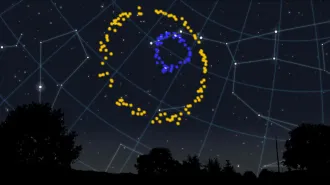View a video of Pluto’s changing hue at the bottom of this article.


Pluto, long thought of as a dormant chunk of ice and rock, has recently undergone some of the most dramatic surface changes of any body in the solar system. And Marc Buie has the images to prove it.
When Buie, a planetary scientist at the Southwest Research Institute in Boulder, Colo., completed a lengthy analysis of pictures of Pluto taken by the Hubble Space Telescope in 2002 and 2003, he couldn’t believe his eyes. Sometime in the two years before those images were taken, the dwarf planet had inexplicably gotten significantly redder.
The abrupt color change “has gotten me scared for a while,” Buie told reporters during a telephone press briefing on February 4. An increase in the amount of ultraviolet sunlight breaking down methane on Pluto’s surface could account for the redder hue. But Pluto’s position relative to the sun didn’t change enough during that two-year period to provide such higher UV levels. “That’s what makes it so surprising,” Buie noted.
The newly released images provide a view of Pluto similar to the naked-eye view of the moon from Earth. The pictures include the sharpest ones of the dwarf planet likely to be taken until shortly before NASA’s New Horizons mission arrives at Pluto in 2015, Buie said.
A comparison of Hubble images taken by two different cameras shows that the northern hemisphere brightened while the southern hemisphere darkened between 1994 and 2002. Pluto’s highly elongated 248-year orbit around the sun, which provides the body with seasons that are highly unequal in length, is the likely culprit behind some of those changes, Buie said.
Pluto’s frigid location “is the only place in the solar system where we can study these sorts of worlds with these frosts and atmospheres that freeze in extreme orbits,” commented Michael Brown of Caltech. Although Pluto is not the biggest denizen of this region, it’s the closest to Earth, and it’s the place scientists are likely to learn the most about the evolution of such bodies, he added.
Details of the study, which took four years of computer analysis, will appear in the March Astronomical Journal.
Pluto Spin from Science News on Vimeo.
Images of the different sides of Pluto, as seen by the Hubble Space Telescope in 2002 and 2003, were assembled to create this video.
Credit: M. Buie/Southwest Research Institute, NASA, ESA







